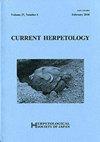Temporal Changes in Number of Breeding Individuals of the Amami Tip-Nosed Frog
IF 0.7
4区 生物学
Q4 ZOOLOGY
引用次数: 2
Abstract
Abstract: Amami tip-nosed frog (Odorrana amamiensis) is an endangered species endemic to Amami-Oshima Island and Tokunoshima Island, in Japan. This species is threatened by invasive species and habitat destruction. Although action is needed to protect them, the breeding ecology of O. amamiensis is poorly understood. A better understanding of its breeding ecology would contribute to conservation efforts. This study reports temporal changes in number of O. amamiensis breeding individuals in Kinsakubaru area, Amami-Oshima Island from the 28 Nov. 2015 to the 5 Dec. 2015. A 20 m transect line was set at a stream to count the number of O. amamiensis individuals at night and during daytime for eight days. Over 200 individuals were observed and many of them were breeding with lively mating calls around the small stream at night for three days. The high density of individuals decreased rapidly afterwards. This is the first report quantifying the temporal changes in number of breeding individuals of O. amamiensis. The species is usually nocturnal, but some individuals were observed at breeding sites during the daytime as well. Field research on O. amamiensis is usually conducted at night, but it can be risky because the nocturnal poisonous snake Habu (Protobothrops flavoviridis) also inhabits Amami-Oshima Island. The results suggested that field research during daytime was relatively safer and perhaps an easier approach to find breeding sites of O. amamiensis compared to searching at night.奄美尖鼻蛙繁殖个体数量的时间变化
摘要:阿玛美尖鼻蛙(Odorana amamiensis)是日本阿玛美大岛和东浓岛特有的濒危物种。该物种受到入侵物种和栖息地破坏的威胁。尽管需要采取行动来保护它们,但人们对阿曼O.amamiensis的繁殖生态学知之甚少。更好地了解其繁殖生态将有助于保护工作。本研究报告了2015年11月28日至2015年12月5日期间,阿玛美大岛金砂库丸地区阿玛美O.amamiensis繁殖个体数量的时间变化。在溪流处设置一条20米的样条线,连续8天在夜间和白天计数阿曼O.amamiensis的个体数量。观察到了200多只个体,其中许多在夜间的小溪流周围通过生动的交配叫声繁殖了三天。高密度个体随后迅速减少。这是第一份量化阿曼O.amamiensis繁殖个体数量随时间变化的报告。该物种通常是夜间活动的,但也有一些个体在白天在繁殖地被观察到。对阿曼岛O.amamiensis的实地研究通常在晚上进行,但这可能是有风险的,因为夜间毒蛇Habu(Protobhrops flavoviridis)也栖息在阿曼大岛上。研究结果表明,与夜间搜索相比,白天的实地研究相对更安全,也许更容易找到阿曼奥密斯的繁殖地。
本文章由计算机程序翻译,如有差异,请以英文原文为准。
求助全文
约1分钟内获得全文
求助全文
来源期刊

Current Herpetology
Agricultural and Biological Sciences-Animal Science and Zoology
CiteScore
1.20
自引率
14.30%
发文量
20
期刊介绍:
Current Herpetology publishes original research articles on amphibians and reptiles. It is the official journal of the Herpetological Society of Japan and is a continuation of Acta Herpetologica Japonica (1964–1971) and Japanese Journal of Herpetology (1972-1999).
 求助内容:
求助内容: 应助结果提醒方式:
应助结果提醒方式:


